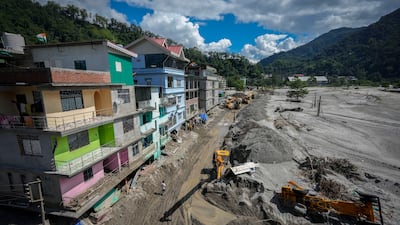In the first week of October, a devastating flash flood triggered by a glacial lake outburst and intense rain in a remote Himalayan mountain tore through Sikkim state, cracking a 1,200-megawatt hydroelectric power plant and sending a torrent of water cascading into the valley below, killing at least 80 people.
The flood was so strong that it submerged dozens of villages in the Teesta river basin and swept away people, animals, homes and vehicles in a flash, the latest example of how climate change is impacting fragile regions of India.
The incident shocked the entire nation but once again underscored the sensitivity of the Himalayan region and the hazards of rampant infrastructure building.
At least 500 people have lost their lives in the Himalayan states of Sikkim, Himachal Pradesh and Uttarakhand in the last three months due to devastating rainfall and widespread destruction caused by flash floods, landslides and cloudbursts.
India's weather office describes a cloudburst as an event in which 100mm of rain falls within an hour.
At least 400 people were killed in northern Himachal Pradesh area, which received 742mm of rainfall in the first 54 days of monsoon season, falling on the region in June, against the seasonal average of 730mm in four months until September, the weather department said.
More than 10 districts of the mountainous state lined with pine trees, valleys, deep rocky gorges and winding rivers flowing from the Himalayas suffered severe damage.

In Shimla, a summer resort once a favoured getaway spot during British rule, two landslides led to the deaths of at least 18 people in two days on August 14 and 15.
More than 2,500 houses were seriously damaged and 11,000 houses were partially damaged across the state, the government said last week.
Roads caved in, railway tracks hung in the air after the earth under them was swept away and cars were submerged in the deluge.
The government said the scale of the death and destruction was unprecedented. It has estimated a monetary loss of about 800 billion rupees ($9 billion).
Similar devastation was seen in the neighbouring Uttarakhand – also a Himalayan state – where at least 50 people were killed in flash floods and landslides.

Climate change
Experts say the unprecedented rain in the northern states was the result of climate change.
India’s monsoon pattern has been changing over the past decade, experts say.
“The global temperature is increasing and once it rises, the capacity of the moisture in the air also increases leading to intense downpours over a limited area,” Mahesh Palawat, vice president of Skymet Weather, a private forecaster, told The National.
“The rainfall that used to last for over three days is now happening for as little as 10 to 24 hours.”

Mr Palawat said the combination of weather systems such as the western disturbance, a type of tropical storm in the region, excess monsoon moisture over the Himalayan foothills, humid wind from the Bay of Bengal as well as the Arabian Sea, was resulting in continuous downpours for a longer duration.
The western disturbance is a system that originates in the Mediterranean Sea and brings moisture-rich clouds to the subcontinent.
“This year’s rain was unusual. This is because of climate change. There will be more such extreme weather events in future,” he said.
Human impact
Climate activists and environmentalists also point to rampant construction in the ecologically sensitive region as being behind the large-scale devastation.
Both Himachal Pradesh and Uttarakhand are the mountainous regions in the country nestled in the lap of the Himalayas – the youngest mountain range in the world.
The Himalayas are fragile because they are still rising in altitude, experts say.
The two states are popular tourist destinations because of their abundant natural beauty as well as dozens of significant Hindu temples, receiving tourists all year round.
This has led to the wide-scale construction of houses, hotels and roads for connectivity, cutting through hills and changing the ecology of the region. In turn, the mass construction increases the rate of rainfall run-off on high ground, worsening flood risk.

Reckless construction of dams as well as massive hydropower projects across the vast network of Himalayan rivers are also a factor.
In Uttarakhand, more than 75 small and large power projects are operational and dozens more are planned to produce clean electricity under India’s commitment to the Paris Agreement to reduce greenhouse emissions.
In several areas, the course of the rivers has been changed because of these dams.
“The Himalayas are fragile like a baby but the region has been seeing aggressive development activities,” Anil Prakash Joshi, founder of Himalayan Environmental Studies and Conservation Organisation, told The National.
“Most of the cities, and towns that are coming up do not have any construction policy to take care of the ecosystem and ecology.”
Mr Joshi said that while developmental work cannot be stopped in the region, it is essential to look at the need, downscale projects and use adequate technology.
“We are building houses and roads, reaching every corner of the states but unfortunately using the technology which is used in the flatlands,” he said.
“There are always two schools of thought. Environmentalists are called anti-development while development guys don’t understand ecology. There has to be a middle path. The construction should go smaller as we go higher, following the topography of the Himalayas where trees get shorter with height.”
Manshi Asher of Himdhara, an environment research collective based in Himachal Pradesh, said the rampant infrastructure construction is a result of a lack of regulation and planning “compromised by vested interests”.
“Mitigation measures cannot be techno-managerial, top-down and short-term,” she said. “It needs to be a well co-ordinated, vision-led policy and governance shift with residents and their livelihood and survival needs at the centre.”


